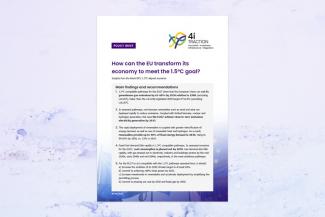
4i-TRACTION (2023): Transformation Scenarios for the EU: How Can the EU Transform Its Economy to Meet the 1.5°C Goal? 4I-TRACTION Policy Brief. Climate Analytics. Updated version_v2, Berlin.
How Can the EU Transform Its Economy to Meet the 1.5°C Goal?
What does the 1.5°C goal require from EU climate policy? This 4i-TRACTION policy brief analyses the latest 1.5°C-aligned scenarios and spells out what they imply for EU climate policy.
Limiting global warming to 1.5°C will require rapid greenhouse gas emission reductions and achieving a net-zero energy system by mid-century. Such transformative change could be realised in a range of ways, and there is need to further assess the implications of these for different world regions and individual countries to guide policy interventions and investments.
This policy brief uses the latest evidence assessed by the IPCC to explore what transformation may be necessary for the EU27 to fulfil the Paris Agreement goal. Using two technically feasible illustrative pathways produced by integrated assessment models, the brief explores how emissions and final energy demand evolve in the future for the EU27 in 1.5°C compatible pathways. The brief then compares this potential evolution to the current set of targets and the underlying modelling.
Main Messages From the Policy Brief
- 1.5°C compatible pathways for the EU27 show that the European Union can cut its greenhouse gas emissions by 62-66% by 2030 relative to 1990 (excluding LULUCF), faster than the currently legislated 2030 target of 53.9% (excluding LULUCF).
- In assessed pathways, non-biomass renewables such as wind and solar are deployed rapidly to reduce emissions. Coupled with limited biomass, nuclear and hydrogen generation, this sees the EU27 achieve close to zero-emissions electricity generation by 2035.
- This rapid deployment of renewables is coupled with greater electrification of energy demand, as well as use of renewable heat and hydrogen. As a result, renewables provide up to 52% of final energy demand in 2030, rising to 93-95% by 2050, vs. 23% in 2019.
- Fossil fuel demand falls rapidly in 1.5°C compatible pathways. In assessed scenarios for the EU27, coal consumption is phased out by 2030. Gas demand also falls rapidly, with gas phased out in the electricity, industry, and buildings sectors by the mid-2030s, early 2040s and mid-2040s, respectively, in the most ambitious pathways.
For the EU27 to be compatible with the 1.5°C pathways assessed here, it should:
- Increase the ambition of its 2030 climate target to at least 62% (excluding LULUCF).
- Commit to achieving 100% clean power by 2035.
- Increase investments in renewables and accelerate deployment by simplifying the permitting process.
- Commit to phasing out coal by 2030 and fossil gas by 2050.
The policy brief is available for download.